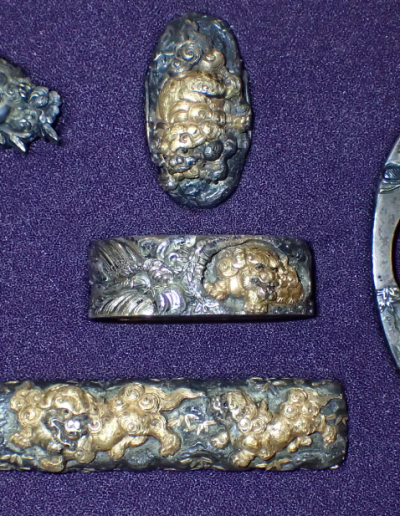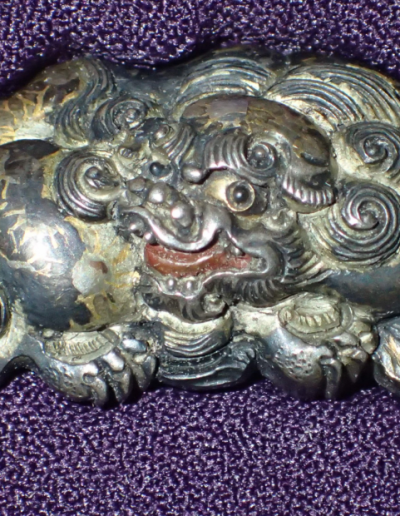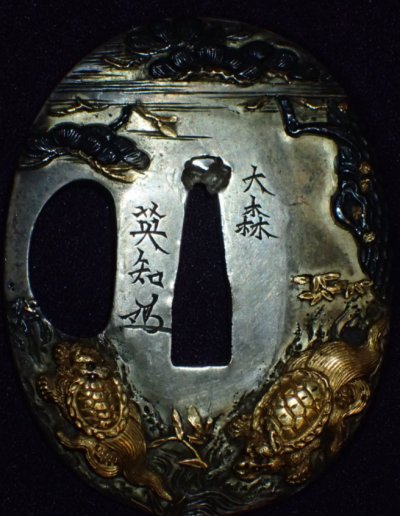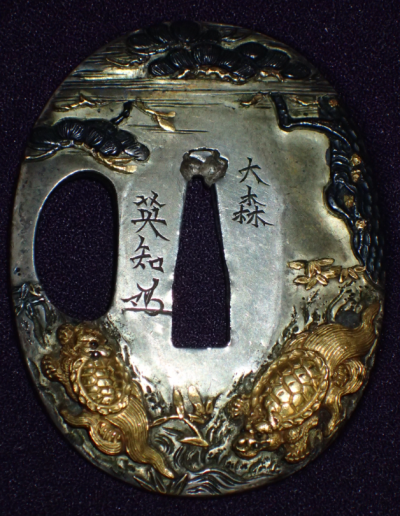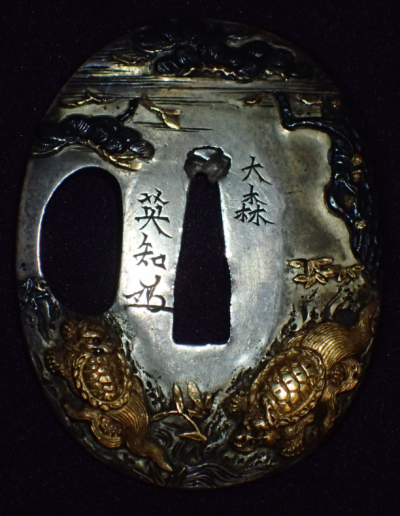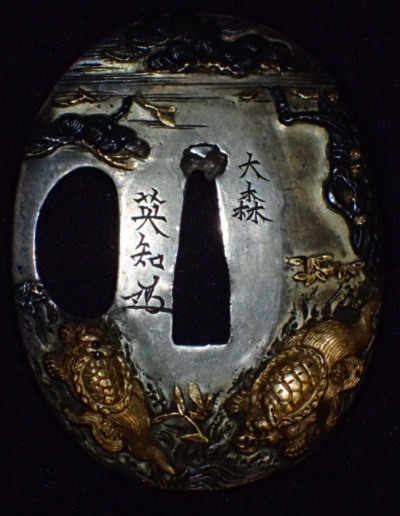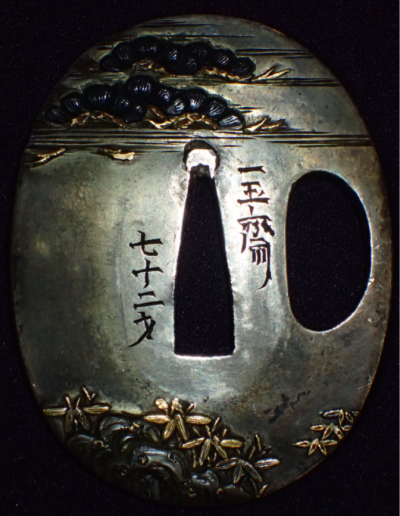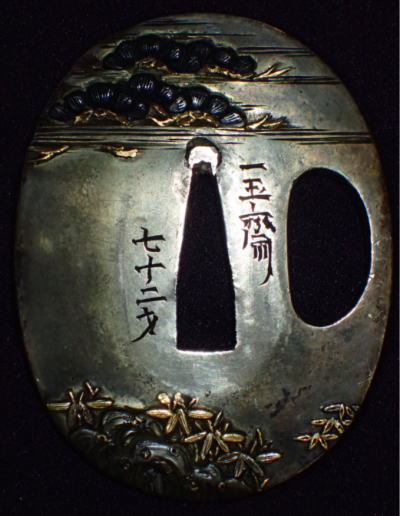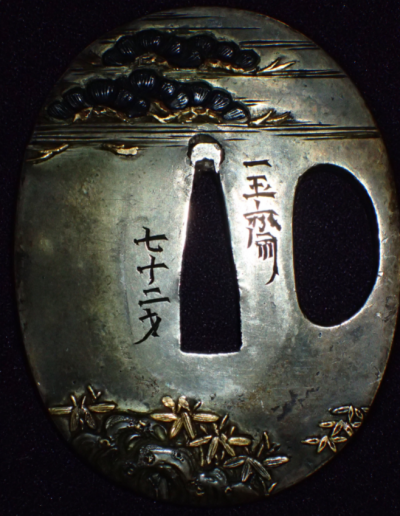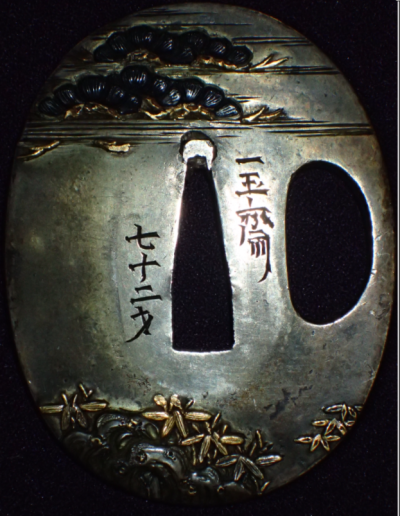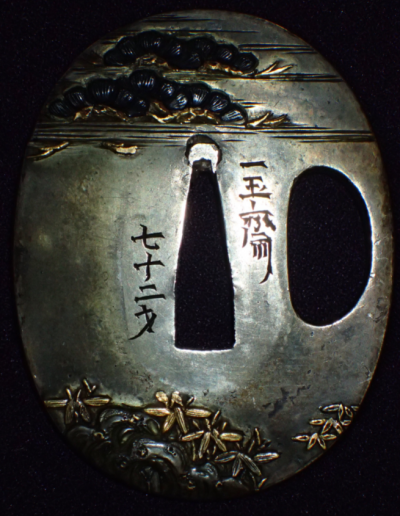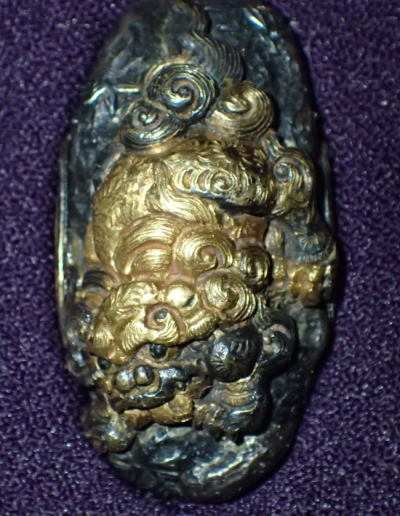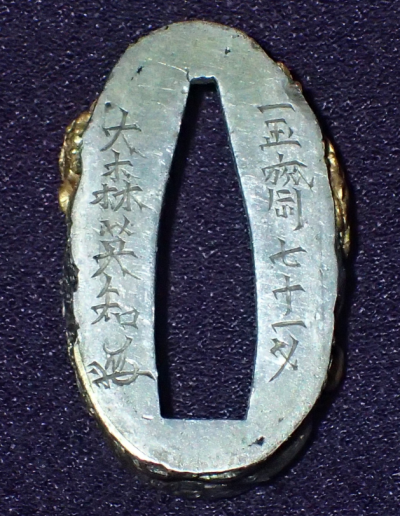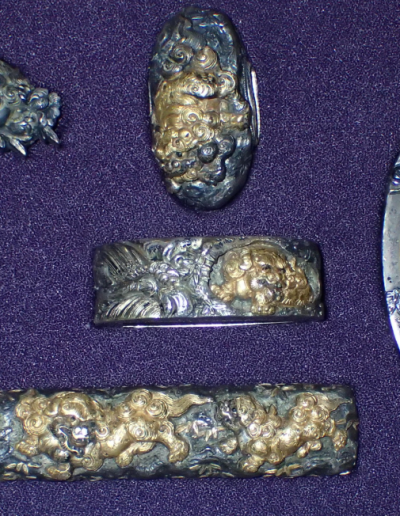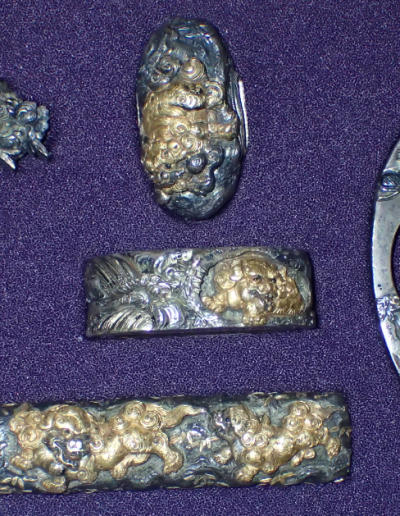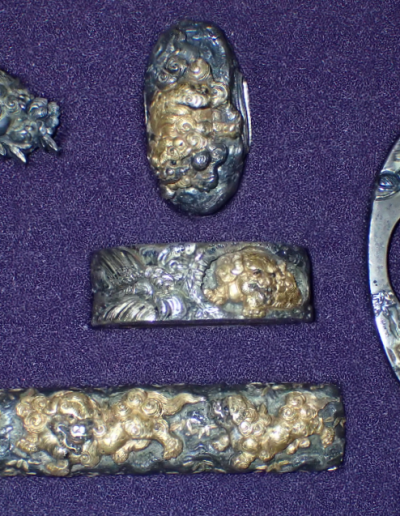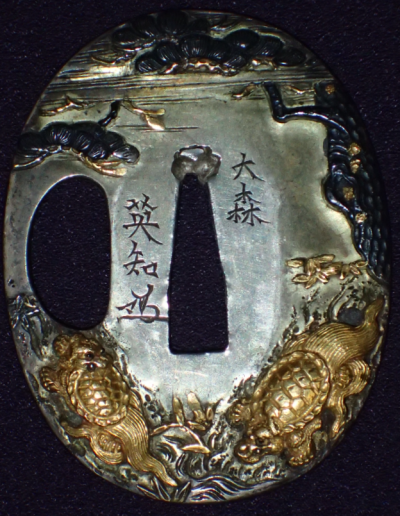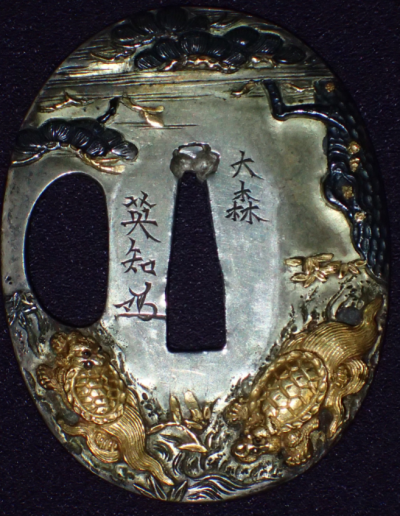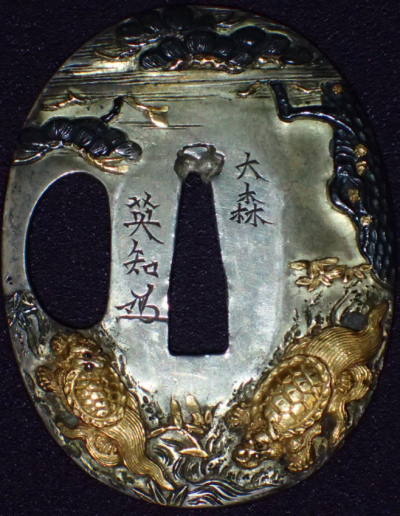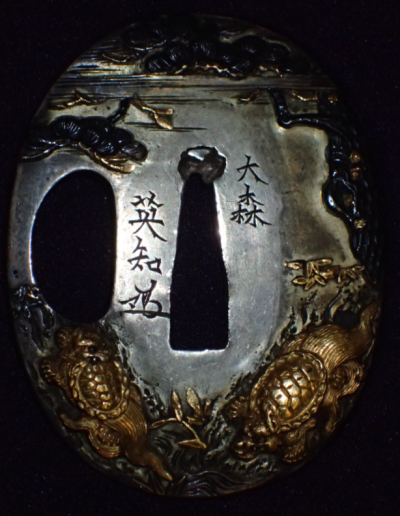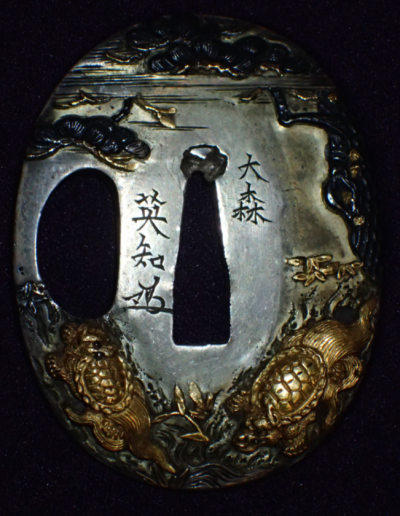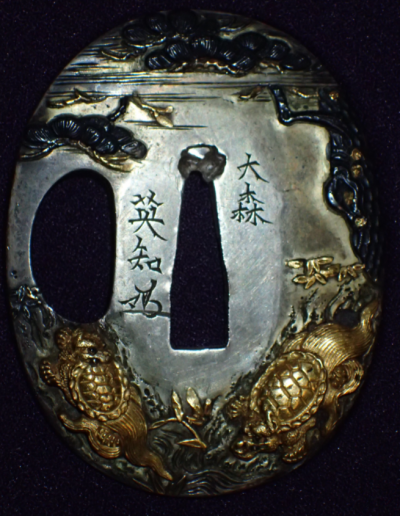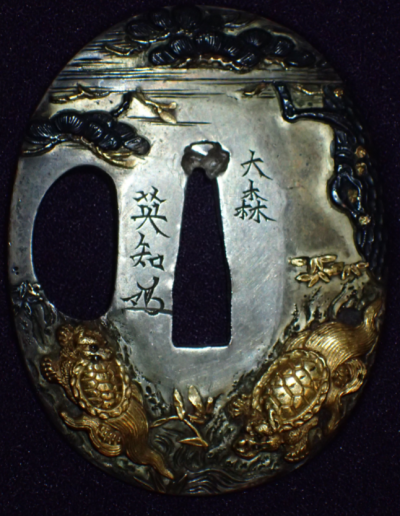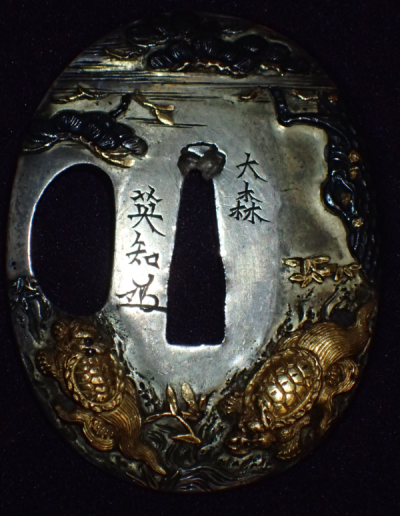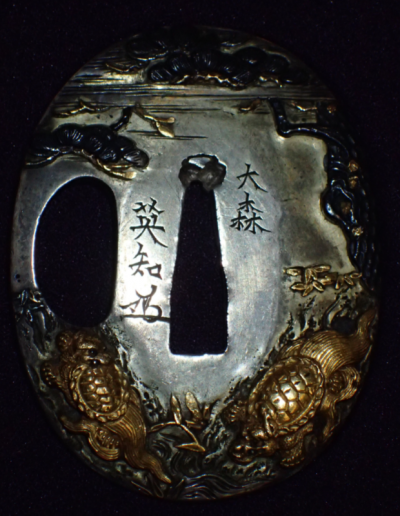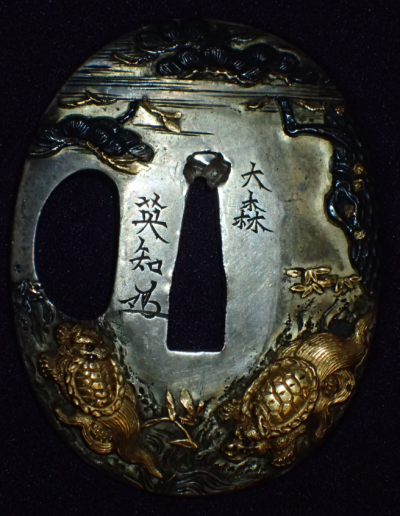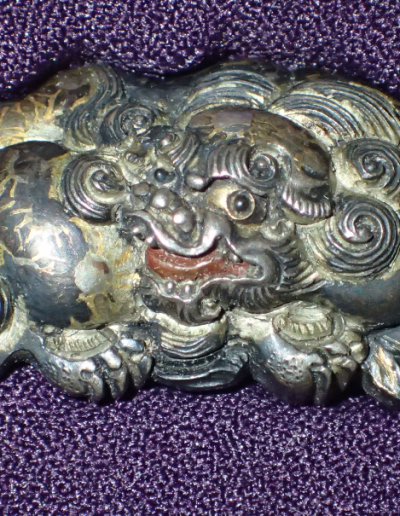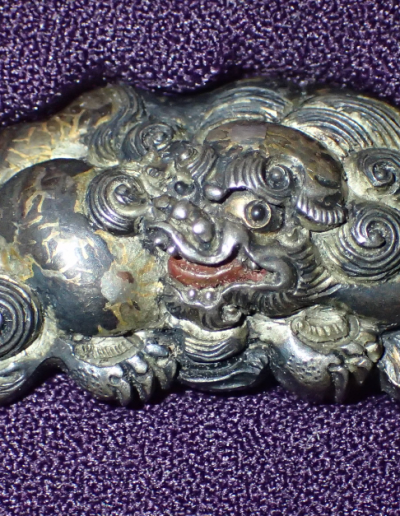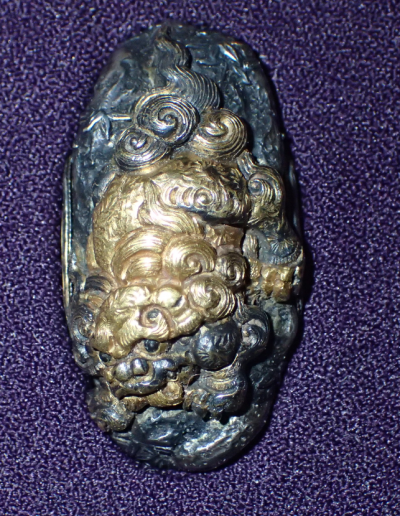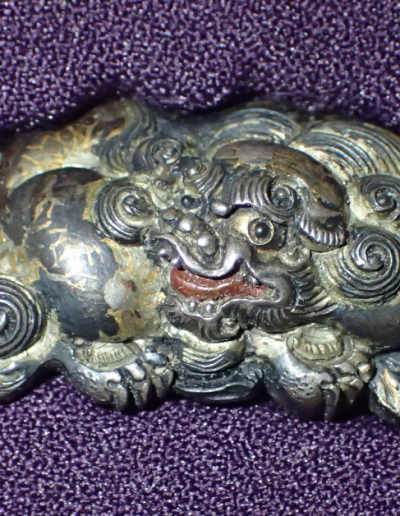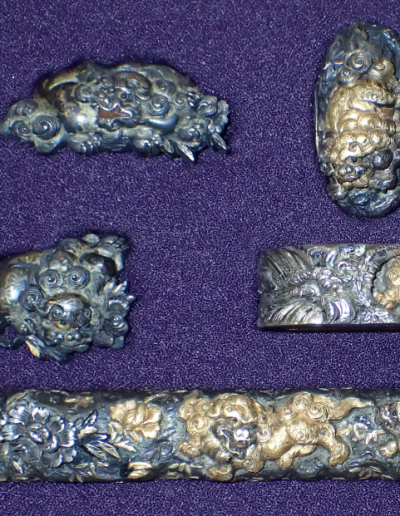Poa
Excellent set of very high quality solid Silver fittings with Gold and Shakudo made by by the master Omori Terutomo also sometimes called Hidetomo, This set shows the incredible skill of this maker , The Omori school were masters of metalwork and have created many outstanding masterpieces.
The Tsuba has the motif of Bamboo , pine trees and Minogame which is a mythological giant turtle which are all symbols of longevity and good fortune. The minogame is regarded as a very auspicious creature in Japanese culture and has made appearances in many arts,
The Minogame is said to live at least a thousand years with some living up to 10,000 years! and have a long, hairy tail, which is actually seaweed and algae that have grown on its shell due to its ripe old age! It has very similar to the real-life common tortoise, which can live for hundreds of years. In Japanese culture, the Minogame represents longevity and wisdom, and is a long-revered symbol of both. In art, it is often shown with other gods and symbols of longevity, such as the crane, or Taoist deities such as Jurōjin. The Minogame is also often depicted with the Three Jewels, which represent fortune.
The Minogame is said to live at least a thousand years with some living up to 10,000 years! and have a long, hairy tail, which is actually seaweed and algae that have grown on its shell due to its ripe old age! It has very similar to the real-life common tortoise, which can live for hundreds of years. In Japanese culture, the Minogame represents longevity and wisdom, and is a long-revered symbol of both. In art, it is often shown with other gods and symbols of longevity, such as the crane, or Taoist deities such as Jurōjin. The Minogame is also often depicted with the Three Jewels, which represent fortune.


The Menuki are motif of Peony flower & karajishi / Shishi , Lion Dogs which in Japanese Mythology are believed to ward off evil spirits
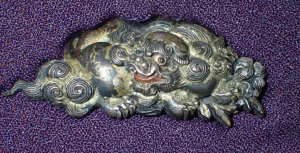
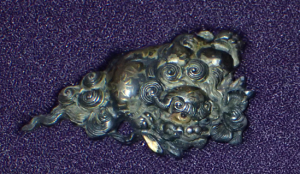
The Fuchi Kashira are high relief Takabori carving of Shishi and Peony.
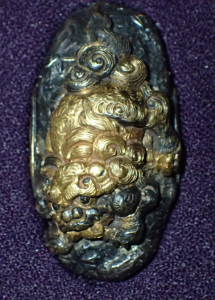
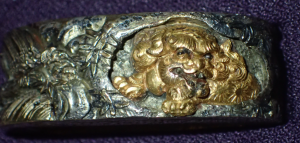
The Kozuka is highly detailed Takabori carving in the motif of Peony and Shishi and Cub.

Translation of NTHK Certificate
Kantei – sho (鑑定書) ‒ Appraisal
Soroi – kanagu (揃⾦具) ‒ Set of fittings
Edo Ichigyokusai Ōmori Terutomo (江⼾⼀⽟斎⼤森英知) ‒ Ōmori Terutomo, art name Ichigyokusai, from EdoShōshin (正真) ‒ Authentic
Reiwa 1 nen 11 gtsu 17 nichi (令和元年⼗⼀⽉⼗七⽇) ‒ November 17, 2019
Non-Profit Organization (特定⾮営利活動法⼈) Nihon Tōken Hozon Kai (⽇本⼑剣保存会) ‒ NTHK
Board Chairman (理事⻑): Miyano Teiji (宮野貞司)
Certificate No 10327Meibun (銘⽂) ‒ Signature:
Tsuba , fuchi gashira , menuki , and kozuka signed “Ōmori Terutomo + kaō ” (⼤森英知「花押」) plus ages 71 to 73Set
Tsuba , fuchi gashira , menuki , and kozuka signed “Ōmori Terutomo + kaō ” (⼤森英知「花押」) plus ages 71 to 73Set
Tsuba , fuchigashira , menuki , kozukaShitaji (下地) ‒ Foundation: of pure silver
Zugara (図柄) ‒ Motif:
Peony and shishi lion design
Peony and shishi lion design
Hori (彫り) ‒ Carvings:
Takabori relief, zōgan inlay, iroe color accentsKoshirae (拵え) ‒ Mounting: menuki of silver, in kata chibori , depicting shishi lions signed via tanzaku – mei : “Ōmori ‒ Terutomo” (⼤森、英知)Bikō (備考) ‒ Remarks:
Second generation, late Edo period
Takabori relief, zōgan inlay, iroe color accentsKoshirae (拵え) ‒ Mounting: menuki of silver, in kata chibori , depicting shishi lions signed via tanzaku – mei : “Ōmori ‒ Terutomo” (⼤森、英知)Bikō (備考) ‒ Remarks:
Second generation, late Edo period
shinsaʼin natsuʼin (審査員捺印) ‒ Seals of Judges: 5 seals
Other artists of the Ōmori school
The most outstanding students of Terumasa were Terutatsu (英辰) and Terutomo (英知) from the Tokuno family (徳野). Terutatsu´s first names were „Genjirō“ (源次郎) and „Genbei“ (源兵衛). He was born in the second year of Kan´en (1749) and belonged first to the Nobara family (野原) but was allowed to use the family name „Ōmori“ after his subsequent studies under Terumasa and his successor Teruhide. His year of death is unnown but there exists a work with the information „made at the age of 61“, that means he was at least active until 1809. Terutatsu used the gō „Ichimudō“ (一夢堂 or 一無堂) and Terutomo the pseudonym „Ichigyokudō“ (一玉堂).
Terutomo´s successor was his son Hidetomo (秀知) who also signed whilst his father was still alive with „Terutomo“. Terutomo and Hidetomo both used the family name „Ōmori“. Hidetomo´s first name was „Sadabei“ (定兵衛). He also studied under Teruhide and used the gō „Ryūrinsai“ (龍鱗斎). The roots of the Nobara and Tokuno family were in Sendai (仙台). Hidetomo died in the fourth year of Bunka (1807) at the age of 65. A better known student of Hidetomo was Tomohiro (知広) from the Takenouchi family (竹内). But Tomohiro also signed with the family name „Nobara“ and the gō „Ichigyokudō“ (一玉堂), so it seems that the latter was used successively by this branch of the Ōmori family. A student and the later adopted son of Terutatsu was Tokuno Terukatsu (英勝).
Terutomo´s successor was his son Hidetomo (秀知) who also signed whilst his father was still alive with „Terutomo“. Terutomo and Hidetomo both used the family name „Ōmori“. Hidetomo´s first name was „Sadabei“ (定兵衛). He also studied under Teruhide and used the gō „Ryūrinsai“ (龍鱗斎). The roots of the Nobara and Tokuno family were in Sendai (仙台). Hidetomo died in the fourth year of Bunka (1807) at the age of 65. A better known student of Hidetomo was Tomohiro (知広) from the Takenouchi family (竹内). But Tomohiro also signed with the family name „Nobara“ and the gō „Ichigyokudō“ (一玉堂), so it seems that the latter was used successively by this branch of the Ōmori family. A student and the later adopted son of Terutatsu was Tokuno Terukatsu (英勝).
ref Markus Sesko


